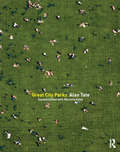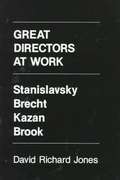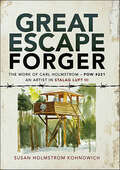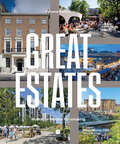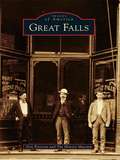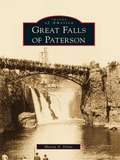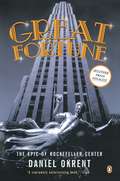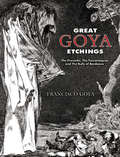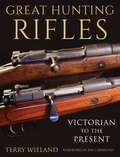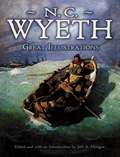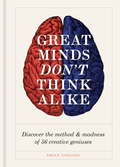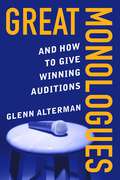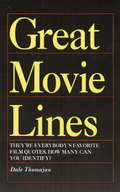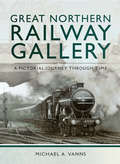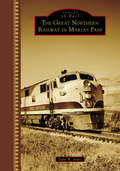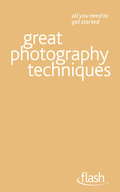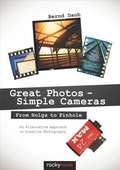- Table View
- List View
Great British Cars: Classic Models from the 1950s to the 1970s
by Stephen BarnettGreat British Cars celebrates the cars commonly seen on the nation’s roads during a golden age of motoring from the 1950s to the 1970s. Featuring 40 classic models such as the Ford Zephyr, Hillman Imp, Triumph Herald, Ford Capri, Vauxhall Viva and the Morris Minor 1000, this is a beautifully illustrated and nostalgic road trip back in time.
Great Chicago Fire, The
by John Boda Ray JohnsonAfter a hot and very dry summer, Chicago was largely a wooden tinderbox awaiting a spark that would come on the Sunday night of October 8, 1871. What became known as �the Great Chicago Fire� was a massive firestorm that moved faster than most men could run, fueled by southwest winds of at least 30 miles per hour. The heat was so intense it melted stone and brick buildings in minutes and turned sand on the lakeshore into glass. A total of 18,000 buildings were destroyed. About 100,000 were left homeless, and over 300 lost their lives. The very same day, and nearly the same hour, both the Lower Peninsula of Michigan and Peshtigo, Wisconsin, suffered similar firestorms. Peshtigo�s was even worse, creating an event that came to be known as �the Peshtigo Paradigm.� Many people believe the three fires forming a huge triangle of destruction were related as one with cosmic causes, and it remains a mystery to this day.
Great City Parks
by Alan TateGreat City Parks is a celebration of some of the finest achievements of landscape architecture in the public realm. It is a comparative study of thirty significant public parks in major cities across Western Europe and North America. Collectively, they give a clear picture of why parks have been created, how they have been designed, how they are managed, and what plans are being made for them at the beginning of the twenty-first century. Based on unique research including extensive site visits and interviews with the managing organisations, this book is illustrated throughout with clear plans and photographs– with this new edition featuring full colour throughout. Tate updates his seminal 2001 work with 10 additional parks, including: The High Line in NYC, Golden Gate Park in San Francisco and Westergasfabriek, Amsterdam. All the previous city parks have also been updated and revised to reflect current usage and management. This book reflects a belief that well planned, well designed and well managed parks and park systems will continue to make major contributions to the quality of life in an increasingly urbanized world.
Great Directors at Work: Stanislavsky, Brecht, Kazan, Brook
by David Richard JonesMy subject is theatre directing in four internationally famous instances. The four directors--Konstantin Stanislavsky, Bertolt Brecht, Elia Kazan, and Peter Brook--all were monarchs of the profession in their time. Without their work, theatre in the twentieth century--so often called "the century of the director" --would have a radically different shape and meaning.
Great Drawings of Nudes: 45 Works
by Carol Belanger GraftonThis volume offers an impressive sampling of life drawings by 45 of the art world's greatest masters. From Albrecht Dürer's 15th-century brush-and-ink drawing of Female Nude, Seen from the Back and Modigliani's mixed media presentation of Caryatid to splendid drawings by Raphael, Rubens, van Dyck, Hogarth, Constable, Ingres, Gauguin, Matisse, and 35 other outstanding artists, these carefully selected plates display the varying styles and traditions of drawing the human figure over five centuries. Of great value to students and artists, this collection will be welcomed by museum-goers and lovers of fine art everywhere.
Great Escape Forger: The Work of Carl Holmstrom—POW#221. An Artist in Stalag Luft III
by Susan Holmstrom KohnowichCarl Holmstrom’s superb artwork depicts life as a ‘kriegie’ in a unique manner. But, more than that, he spent the major part of his captivity in Stalag Luft III Prisoner of War Camp, famous for ‘The Great Escape’. The audacity of the 76 escapees was only matched by the callousness of the Nazis who murdered 50 after recapture. As well as skillfully recording camp life, Carl forged invaluable official documents. He also sketched his fellow prisoners and encouraged others to take up drawing as hobby. Remarkably he saved over 200 examples of his work by carrying them on the appallingly arduous 1945 winter march from Poland into Germany. Post war, Carl Holmstrom said, “The drawings were made during imprisonment and represent a sincere effort to portray to the American people and especially to the relatives of the prisoners, intimate glimpses of Kriegie life.” His words proved to be prophetic. An expansion of his earlier self-published Kriegie Life, this superb book honors Carl’s exceptional artistic gift. This book has strong claim to contain the finest collection of POW art to emerge from Nazi-occupied Europe.
Great Estates: Models for modern placemaking
by Peter Murray Sarah YatesThe only book that brings together all London’s historic and contemporary Great Estates - documents a remarkable history, unique to England but with lessons for landowners and communities around the world. - Shows how they shape the way development takes place in England – providing essential lessons to all those wishing to understand city planning, whether practitioners or academics. - Provides a model example of corporate modernisation following the impact of leasehold reform. Much of the story of London's development can be traced through the historic ownership of large pieces of land which, through the ongoing ownership of freehold assets and their lease terms, have created a resilient cycle of change and renewal. Today this long-term attitude to investment, development and management has influenced the development of new large-scale and mixed-use areas of the capital, such as King's Cross, Canary Wharf, and the Olympic Park. This book provides a comprehensive picture on all of London’s historic and contemporary estates, and sets out what we can learn from them on the most successful principles of placemaking for the future. Part retrospective, part forward-looking, the book will provide lessons on place-shaping, management and stewardship, for global cities looking to learn from this unique London model.
Great Expectations: Reflections on Museums and Canada
by Jack LohmanA provocative, progressive rejoinder to the status quo, from the perspective of a disrupter and global leader in the museum world.The challenge to transform museums is unapologetically real and complicated. But everything we learn about reconciliation, science and biodiversity, climate change, and sustainability gives us the confidence and freedom to break through the conventions of the past.Each essay in this collection emphasises key features that are driving change in museums, such as globalization, society, authenticity, and technology. Each raises anew older themes within the canon of museology: information versus knowledge, diversity and plurality, the unending accumulation of objects and the incompleteness of collections, modes of perception, and insularity. What emerges is a new way of being a museum that is outward looking and global, and which includes chaos and surprise.A provocative, progressive rejoinder to the status quo, from the perspective of a disrupter and global leader in the museum world.The challenge to transform museums is unapologetically real and complicated. But everything we learn about reconciliation, science and biodiversity, climate change, and sustainability gives us the confidence and freedom to break through the conventions of the past.Each essay in this collection emphasises key features that are driving change in museums, such as globalization, society, authenticity, and technology. Each raises anew older themes within the canon of museology: information versus knowledge, diversity and plurality, the unending accumulation of objects and the incompleteness of collections, modes of perception, and insularity. What emerges is a new way of being a museum that is outward looking and global, and which includes chaos and surprise.
Great Falls
by Don Peterson The History MuseumBefore Meriwether Lewis saw the Great Falls of the Missouri River in 1805, the area had been visited for centuries by plains bison and the Blackfeet Indians. The city's founding father, Paris Gibson, learned of the falls from Lewis and Clark's journals, and with financing from railroader James J. Hill, Gibson began building the city of Great Falls in 1884, capitalizing on its Missouri River location. After the railroad arrived, the first of five hydroelectric dams was built, along with smelters for silver and copper. The year 1909 saw the homestead boom and settlers by the thousands, while World War II's construction boom supported large military facilities in the city. Great Falls' good times lasted 90 years.
Great Falls of Paterson (Images of America)
by Marcia A. DenteIn 1778, the Great Falls became the Paterson area's natural energy source. The innovative hydraulic "Raceway" used an intricate network of canals to channel millions of gallons of water to power local mills and factories. In 1791, Alexander Hamilton helped to organize the Society for the Establishment of Useful Manufactures, which aimed to develop a planned industrial city in the United States. Hamilton believed that the country needed to reduce its dependence on foreign goods and develop its own industries, and the falls were chosen as the site for the planned city. The industries in Paterson were powered by the 77-foot Great Falls, and the city became known as "the cradle of American industry." Today the falls are not only a national historic landmark and a state park, but on March 30, 2009, Pres. Barack Obama signed a bill creating Great Falls National Historical Park.
Great Fortune: The Epic of Rockefeller Center
by Daniel OkrentIn this hugely appealing book, a finalist for the Pulitzer Prize, acclaimed author and journalist Daniel Okrent weaves together themes of money, politics, art, architecture, business, and society to tell the story of the majestic suite of buildings that came to dominate the heart of midtown Manhattan and with it, for a time, the heart of the world. At the center of Okrent?s riveting story are four remarkable individuals?tycoon John D. Rockefeller, his ambitious son Nelson Rockefeller, real estate genius John R. Todd, and visionary skyscraper architect Raymond Hood. In the tradition of David McCullough?s The Great Bridge, Ron Chernow?s Titan, and Robert Caro?s The Power Broker, Great Fortune is a stunning tribute to an American landmark that captures the heart and spirit of New York at its apotheosis.
Great Goya Etchings: The Proverbs, The Tauromaquia and The Bulls of Bordeaux
by Philip Hofer Francisco GoyaA stunning gallery of Goya's later works, this lavish volume presents prints from The Proverbs, La Tauromaquia, and The Bulls of Bordeaux. Its 78 etchings recapture the incomparable grandeur of Goya's art as well as the major themes of his works -- the Bible, human folly, and the brutal pageantry of bullfighting.Savage yet sympathetic, the nightmare visions of The Proverbs are among Goya's most enigmatic works. The realism of La Tauromaquia and The Bulls of Bordeaux is similarly striking, with remarkably accurate images of bulls and fighters. Each etching appears with the original caption and an English translation. Additional text sheds light on the life and times of the great Spanish master. Students, collectors, and other art lovers will prize this magnificently reproduced edition, which is also the lowest-priced collection of Goya's etchings.
Great Hunting Rifles: Victorian to the Present
by Terry WielandIn Great Hunting Rifles, firearms expert Terry Wieland leads the reader on a journey through the history of some of the most exquisite rifles made in the twentieth century.The rifles featured in the book, all personally owned by the author and described in loving detail, were chosen for their particular importance. Each rifle either represents a particular era of gun making, is historically important, or is simply a paragon of gun making skill. In his treatment of these special rifles, Wieland provides a close look at some individual guns that are superb in a unique way, and which illustrate high points of the twentieth century. Each chapter is dedicated to one particular rifle, and is accompanied by photographs of the author's own examples, including:James Woodward hammer double .450 Express 3 1/4" Holland & Holland hammer .500 Express 3 1/4" Haenel-Mannlicher bolt action .450 Ackley custom rifle Mannlicher-Schoenauer Model 1908 Savage Model 1899 Al Biesen custom .270 Winchester .505 Gibbs custom built on a Granite Mountain Mauser 98 And many more! Great Hunting Rifles is perfect for anyone who wants to know more about the history of those few, special rifles that have made their mark on time.
Great Illustrations by N. C. Wyeth
by N. C. Wyeth Jeff A. MengesBefore Andrew and Jamie, there was N. C. Wyeth. The star student of Howard Pyle's Brandywine School, Newell Convers Wyeth (1882-1945) created more than 3,000 illustrations in the course of his career. This original full-color collection focuses on his most popular illustrations, featuring early works that date from 1910-30. More than 100 iconic images include scenes from The Last of the Mohicans, The Mysterious Stranger, Robin Hood, Robinson Crusoe, Rip Van Winkle, The Boy's King Arthur, and other books.Wyeth's fame and greatest commercial success derived from his work for Scribners' Illustrated Classics. Starting with the 1911 edition of Treasure Island, the artist provided images for more than 25 volumes in the series. Many of those illustrations appear here, in a treasury of stirring, dramatic visions that captured the imaginations of the storybook readers of a century ago and continue to speak to modern audiences.
Great Minds Don't Think Alike: discover the method and madness of 56 creative geniuses
by Emily GoslingGreat Minds Don't Think Alike surveys some of the most brilliant minds of the past and present. Discover the methods and rituals they used to forge a constructive, creative pathway, from the downright peculiar to the reassuringly pedestrian.Learn the importance of daily routines with Sylvia Plath, embrace randomness with David Bowie and transcend tragedy with Frida Kahlo. With 56 tried and tested creative techniques from inspired, and inspiring, minds - among them, architects, musicians, playwrights, painters and philosophers - enjoy an illustrated compendium of ingenious insights to kickstart your own creative process.
Great Minds Don't Think Alike: discover the method and madness of 56 creative geniuses
by Emily GoslingGreat Minds Don't Think Alike surveys some of the most brilliant minds of the past and present. Discover the methods and rituals they used to forge a constructive, creative pathway, from the downright peculiar to the reassuringly pedestrian.Learn the importance of daily routines with Sylvia Plath, embrace randomness with David Bowie and transcend tragedy with Frida Kahlo. With 56 tried and tested creative techniques from inspired, and inspiring, minds - among them, architects, musicians, playwrights, painters and philosophers - enjoy an illustrated compendium of ingenious insights to kickstart your own creative process.
Great Moments in Architecture
by David MacaulayA wonderous portfolio that has to be seen to be savored-or even believed for that matter. Here are the plans for the Tower of Pisa-on a skewed drafting table, the Eiffel Tower tipped over across from the Seine, the ruins of a McDonald's stand following some future Vesuvius, the disastrous meeting of the Great and Lesser Walls of China, and many other gems.
Great Monologues: And How to Give Winning Auditions
by Glenn AltermanA must-have resource for aspiring actors: both monologues to audition with and a step-by-step guide on the best monologue audition preparation!Great Monologues: And How to Give Winning Auditions is primarily for actors looking for excellent acting monologues for their monologue auditions. There are original monologues written specifically for auditions, as well as monologues from award-winning playwright Glenn Alterman&’s plays. There are comedic, dramatic, and serio-comedic monologues for all audition calls.Great Monologues also offers a step-by-step process to prepare for all monologue auditions. The monologues offered run from one minute to five minutes, thus covering all audition times. There are also a number of in-depth interviews with major casting directors, directors, and theatre company artistic directors. If you are an aspiring actor in need of an audition monologue, or want the best advice on how to properly audition with a monologue, Great Monologues: And How to Give Winning Auditions is a must-have in your collection!Allworth Press, an imprint of Skyhorse Publishing, publishes a broad range of books on the visual and performing arts, with emphasis on the business of art. Our titles cover subjects such as graphic design, theater, branding, fine art, photography, interior design, writing, acting, film, how to start careers, business and legal forms, business practices, and more. While we don't aspire to publish a New York Times bestseller or a national bestseller, we are deeply committed to quality books that help creative professionals succeed and thrive. We often publish in areas overlooked by other publishers and welcome the author whose expertise can help our audience of readers.
Great Movie Lines
by Dale Thomajan"You must remember this . . . " A kiss is just a kiss, but famous movie lines last forever, and many have become permanently part of American culture. For silver-screen fanatics and current blockbuster buffs, GREAT MOVIE LINES collects and strings together the best of them into the longest and most famous scene of all time. Test your power of recall and challenge your friends. Then fasten your seatbelts, it's going to be a bumpy night!
Great Northern Railway Gallery: A Pictorial Journey Through Time (Railway Gallery Ser.)
by Michael A. Vanns&“A simply fascinating and impressively informative illustrated history&” of the British steam railway by the author of The Leicester Gap (Midwest Book Review). The Great Northern Railway was one of 120 companies that ran trains in Britain during the Victorian and Edwardian period. Formed in 1846, it traded independently for seventy-six years until absorbed into the London & North Eastern Railway on 1 January 1923. Operating a network of nearly 700 route miles it ran trains between King&’s Cross, London and York, into the Eastern Counties and the East Midlands, the West Riding of Yorkshire, into Lancashire and even south of the Thames. It developed distinctive characteristics, both in the way it managed its affairs and in the appearance of its trains, stations, signals and signalboxes. Numerous photographs were taken, particularly from the 1890s onwards, by dedicated amateurs attracted to the lineside by the sight of speeding steam locomotives in apple green livery, hauling polished teak carriages. Goods trains and the endless procession of coal trains were not such popular photographic subjects, but by searching out these and images of staff, stations and signalboxes, this book aims to capture something of the spirit of a once-great organization in the heyday of Britain&’s steam railways. &“With the welcome increase in the pre-Grouping scene engendered by projects such as the Hatton&’s &‘Genesis&’ coaches, books such as this will find a new audience, which is no bad thing.&” —Railway Modeller &“Vanns certainly presents a splendid collection of period images displaying numerous aspects of the railway&’s operations.&” —Best of British
Great Northern Railway in Marias Pass, The (Images of Rail)
by Dale W. JonesMontana’s Marias Pass is the lowest rail crossing through the Rocky Mountains. The tracks snake through narrow canyons, traverse the swift Middle Fork of the Flathead River, and twist through numerous snowsheds and tunnels to crest the 5,213-foot Continental Divide. James Jerome Hill was the driving force behind Great Northern Railway’s mission to find the most economical route to the Pacific coast, with surveyor John F. Stevens taking a major role in locating the pass. Browning is the eastern gateway into Marias Pass as the railroad approaches the Rocky Mountain Front; continuing west from Summit, the tracks parallel Bear Creek and the Middle Fork of the Flathead River downgrade through Essex to Glacier National Park and into the Flathead Valley.
Great Ohio River Flood of 1937, The
by James E. CastoFrom the time settlers first pushed into the Ohio Valley, floods were an accepted fact of life. After each flood, people shoveled the mud from their doors and set about rebuilding their towns. In 1884, the Ohio River washed away 2,000 homes. In 1913, an even worse flood swept down the river. People labeled it the "granddaddy" of all floods. Little did they know there was worse yet to come. In 1937, raging floodwaters inundated thousands of houses, businesses, factories, and farms in a half dozen states, drove one million people from their homes, claimed nearly 400 lives, and recorded $500 million in damages. Adding to the misery was the fact that the disaster came during the depths of the Depression, when many families were already struggling. Images of America: The Great Ohio River Flood of 1937 brings together 200 vintage images that offer readers a look at one of the darkest chapters in the region's history.
Great Photography Techniques: Flash
by Lee FrostDo you want to be able to take brilliant photos but dont know where to begin? Get a kickstart with this little book which will give you just enough to get you going...
Great Photography Techniques: Flash
by Lee FrostDo you want to be able to take brilliant photos but dont know where to begin? Get a kickstart with this little book which will give you just enough to get you going...
Great Photos - Simple Cameras
by Bernd DaubWhen we look at everyday life, we realize that it is far from easy. Indeed, we are often confronted with the contrary: complicated instead of simple; demanding instead of effortless. As photographers, we face a similar situation with regard to our chosen hobby. The camera and computer are wonderful technical instruments, but their growing complexity can sometimes take away from the joy we find when we engage in creative work. In this book, author Bernd Daub shows us that simplicity works. He describes how with simple camera techniques, traditional film, and some imagination we can create ambitious artwork. This book teaches us how to focus our attention on the motivation behind our chosen image and develop a strong image impact without the need for high-tech equipment and flawless exposures. Learn about a variety of reasonably priced, low-tech cameras-such as the Holga, Diana, and Blackbird-as well as single-use cameras, the good old Agfa-Box, and the pinhole camera. For price-conscious beginners and intermediate photographers with high-quality equipment, this book provides ideas for alternative techniques without large investments. You'll discover many new possibilities as you foster your creativity.


